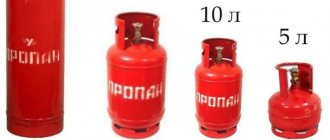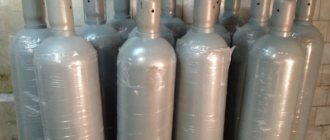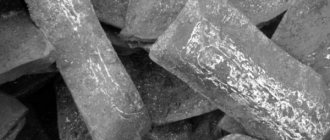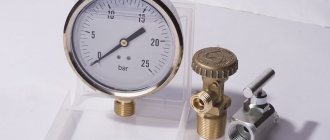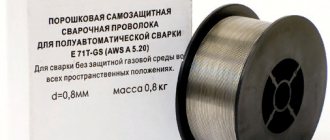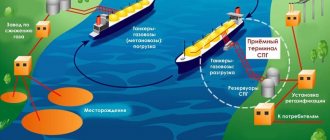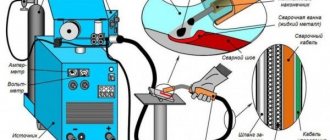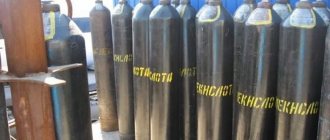Types of gases
Gases used in welding are divided into active and inert, among the active there are reactive and neutral. Moreover, the active gas can be reactive under some conditions and types of welding, and neutral under others.
All of them are pumped into special welding cylinders. Before ordering gas for work, you should familiarize yourself with the types of standard markings, the possibility of subsequent filling of cylinders with welding mixture, and their equipment.
All gases are pumped into cylinders under pressure . Therefore, containers are made of steel that does not have seams. Only at a pressure less than 3 MPa can gas containers be welded or have a seam.
In welding practice, such types are not found. Gases for welding are supplied only in cylinders without seams with special shut-off valves. Fundamentally different valves are designed for different gases.
Cylinders with gaseous flammable hydrocarbons - acetylene, propane, butane and others - are equipped with valves with left-hand threads.
Cylinders with all other gases, including oxygen, nitrogen, carbon dioxide and inert gases, are equipped with valves with right-hand threads.
The difference in the directions of rotation of the valve eliminates the possibility of accidental errors, accidents during welding or other use of gas.
Gas cylinders - operating rules | Web Mechanic
Good afternoon dear friends. Today I have prepared a large topic about the rules for using gas cylinders. Let's begin!
Gas cylinders: painting, inscriptions, markings
The information about the cylinder must be clearly stamped on the top spherical part of the cylinder:
1. Cylinder number2. Test point stamp (diameter 12 mm)3. Manufacturer's trademark4. Working pressure (kgf/cm2)5. Actual weight of an empty cylinder, kg6. Quality control stamp of the manufacturer (diameter 10 mm)7. Capacity, l8. Test hydraulic pressure, (kgf/cm2)9. Month and year of manufacture (IV-1999) and year of the next (2004) survey
10. Month and year of the survey carried out (IV-2004) and the year of the subsequent (2009) survey
In addition, acetylene cylinders must indicate:
M III-99 - date (month and year) of filling the cylinder with porous mass III-01 - month and year of checking the porous mass
— stamp of the filling station
— a stamp with a diameter of 12 mm, certifying the verification of the porous mass
It is allowed to release gas from the cylinder only through a reducer designed for this gas and painted in the appropriate color!
- Protective cap
- Valve
- Neck thread
- Passport details
- Porous mass
- Backing rings
- Support shoe
1. Protective cap2. Valve4. Passport details
6. Backing rings
Rejection of cylinders
External damage to the cylinder due to which it must be rejected: 1. Malfunction of the valve 2. Wear of the neck thread 3. Not all data is knocked out or the inspection period has expired 4.
Severe external corrosion 5. Cracks 6. Painting and lettering are not up to standard 7. Dents 8. Bulges 9. Sinks and scratches with a depth of more than 10% of the nominal wall thickness 10.
A misaligned or damaged shoe
Also, gas cylinders are not allowed for use if:
| GEARBOX: | PRESSURE GAUGE: | VALVE: |
| - when the adjusting screw is fully turned out, gas passes into the working chamber - the thread of the union nut is damaged - one or both pressure gauges are faulty - the pressure in the working chamber has increased after stopping the gas supply - the safety valve is faulty | - there is no seal or stamp with an inspection mark - the inspection period has expired - when the pressure gauge is turned off, the needle does not return to zero by an amount greater than half the permissible error - the glass is broken or there are other damages that may affect the accuracy of the readings | - there is no fitting plug - there are traces of oil, grease, dust - the handwheel does not turn - there is a gas leak |
It is forbidden to completely consume the gas from the cylinder! The residual pressure must be at least 0.05 MPa (0.5 kgf/cm2)
The residual pressure in acetylene cylinders must not be lower than the following values:
| Ambient temperature | 0C | below 0 | 0-15 | 16-25 | 26-35 |
| Minimum residual pressure | MPa | 0,05 | 0,1 | 0,2 | 0,3 |
| kgf/cm2 | 0,5 | 1,0 | 2,0 | 3,0 |
Diagram of the design and operation of a gas cylinder reducer
Non-working and working position of the gearbox
In the left figure, the gearbox is in the non-working position. Gas (the gas filling area is colored blue) does not pass through in this case. In the right picture, the reducer is in the operating position, gas passes through the reducer.
Gearbox structure: 1. Union nut for connecting the gearbox to the valve fitting2. High pressure gauge3. Return spring4. Low pressure gauge (working)5. Safety valve6.
Nipple for connecting a hose7. Membrane for rubberized fabric8. Pressure spring9. Adjusting screw 10. Working (low pressure) chamber 11. Pressure reducing valve
12.
High pressure chamber
Transportation of gas cylinders
Transportation of gas cylinders by car: Cylinders are laid horizontally within the height of the side in no more than 3 rows.
Transportation of gas cylinders on a truck: The cylinders are laid horizontally in one row, with valves in one direction - to the right of the cabin.
Transportation of gas cylinders in a special container: Cylinders are transported in a vertical position.
It is allowed to transport oxygen and acetylene cylinders together in a container.
Propane cylinders can be transported in an upright position without containers, always with gaskets between the cylinders and protecting them from falling.
Substrates for transporting gas cylinders
1. A wooden block with nests cut out for the cylinder2. Nest upholstery: felt, rubber or other soft material3. The caps must be screwed in completely, the fittings must be plugged
4. Rope or rubber rings with a thickness of at least 25 mm (two rings per cylinder)
It is PROHIBITED to transport cylinders with different gases together, as well as empty ones together with filled ones!
| Transportation on a special trolley with rubber springs. It is allowed to transport oxygen and acetylene cylinders together1 - Clamp |
| Carrying on a stretcher1 - Clamps |
| Turning on a shoe in an inclined position |
When loading or unloading, it is prohibited:
- Work alone (at least 2 people must participate)
- Work in oily clothes, gloves with traces of oil or grease
- Load oxygen cylinders into the body with traces of oil, fuel, dirt, debris
- Carry cylinders on your hands or on your shoulder
- Roll cylinders on the ground
- Dropping cylinders and hitting one another
- Feed or hold the cylinder with the valve down
- Load and unload cylinders without caps and plugs
Caps and plugs on fittings must be tightened
Distance to heating devices is at least 1 m. Distance to heat sources with open fire is at least 5 m.
Cylinders must be protected from the sun and precipitation (maximum temperature of the cylinder body is +45 degrees C)
Cylinders are stored horizontally on wooden frames or racks
The valves must be directed in one direction, the height of the stacks is no more than 1.5 m
It is prohibited to store oxygen in the same room with acetylene or other flammable gases.
When stored vertically, cylinders are installed in special nests, cages, or protected with a barrier from falling
Filled and empty cylinders are stored separately, indicating storage locations with appropriate signs
It is prohibited to store cylinders in basements and attics.
It is prohibited to place flammable and combustible substances in cylinder storage areas.
Do not allow cylinders to come into contact with electrical wires
Work breaks and termination
During short breaks in operation, close only the burner valve without changing the position of the adjusting screw.
In case of any malfunction, immediately close the cylinder valve and release gas from the reducer. Stop gas sampling when the pressure drops to residual.
Close the cylinder valve, screw on the plug and cap and return the empty cylinder to the warehouse.
Gas cylinders: operation
The cylinders are installed vertically and secured with a chain or clamp. The oxygen cylinder can be laid obliquely - so that the valve is located above the shoe.
Unscrew the cap and plug of the fitting. Attention: make sure that there are no traces of oil or grease on the oxygen cylinder (as well as on your hands and overalls). It is PROHIBITED to use a container with traces of oil or fat!
By briefly (1-2 sec) turning the handwheel half a turn, blow out the fitting to remove moisture, dirt, etc. from it. You need to stand behind or to the side of the fitting. You cannot taste the gas with your hand.
Attach the gearbox union nut by hand.
Tighten the gearbox union nut with a wrench.
When attaching an acetylene gearbox, ensure that the clamp is installed correctly.
Turn out the adjusting screw until the pressure spring is completely released.
Connect and securely fasten the hose.
Slowly turn the handwheel 0.5-1 turns and open the gas supply from the cylinder.
Rotate the adjusting screw to set the operating pressure.
Check the connections for tightness.1. Close the gas flow valve on the burner2. Turn out the adjusting screw until the pressure spring is completely released3. After a slight increase in pressure, the needle on the working pressure gauge should stop (the pressure should not increase)
Warm up a frozen valve or reducer only with hot water or steam. The use of open fire is prohibited!
Do not open the valve suddenly! The gas stream electrifies the cylinder neck and reducer, which can cause fire or explosion.1. Close valve 2 immediately. Release the gas from the reducer
Do not allow more than one propane-butane cylinder at the workplace. It is prohibited to work with propane-butane in wells, pits, and trenches.
At least once a quarter, check the safety valve by forcing it open (increasing the pressure until it opens).
Check possible gas leaks with soap emulsion.
Valves
Oxygen:
- 1. Handwheel
- Fitting plug
- Right-hand thread
- open
- closed
Acetylenic:
Rotate the spindle only with a special key.
- Hole for clamp pressure screw
- Left thread
Propane-butane:
- Handwheel
- Fitting plug
- Left thread
- open
- closed
Pressure gauges
The working pressure is indicated by a red line or a metal plate tightly adjacent to the glass.
- Brand
- Warning notice (depending on the type of gas)
Pressure gauge check stamp
- Verifier code
- Quarter (III) and year (2002) of inspection
Check the pressure gauge at least once a year!
Gearboxes
Oxygen
Acetylenic:
- Clamp for connection to the valve
- Pressure screw
Propane-butane
gas cylinders
page on social networks
Coloring
For safety purposes, strictly defined coloring of containers and inscriptions on it have been introduced. The gases most commonly used in cooking are color coded as follows:
- The highly purified argon cylinder is gray in color and has a green inscription on it. The black cylinder with technical argon has a blue inscription. There is also so-called raw argon with its own markings. This gas is not used in welding;
- carbon dioxide cylinders are painted black, the inscription on them is in yellow;
- oxygen cylinders for welding are always blue, and the inscriptions on them are black. Both medical and technical grades of gas are colored this way. In medicine, oxygen is used very often. It is transported on trolleys, then, if necessary, the cylinder is installed in a special case;
- containers containing acetylene, which is very popular in welding, are black in color. Acetylene explodes very easily. Therefore, it is not pumped into empty volumes, but containing special fillers with a large number of pores. This filling method significantly reduces the likelihood of explosions.
It is useful for novice welders to remember the color coding of gases on the domestic market. Do not be surprised if the coloring on imported products is different. International labeling is somewhat different from domestic labeling.
Marking of oxygen cylinders
All information is applied in the valve area and is typed in four lines.
First line: Information about the manufacturer and its trademark. Cylinder number.
Second line: Release date and next required cylinder inspection.
Third line: Hydraulic and working pressure in kgf/cm2.
Fourth line: Volume of oxygen in Liters. Cylinder weight (without valve and cap) in kg.
Marking of carbon dioxide cylinder and acetylene
On these cylinders, information is printed in the valve area. All information is typed into four lines.
First line: Information about the manufacturer and its trademark. Cylinder number.
Second line: Release date and next required cylinder inspection.
Third line: Hydraulic and working pressure in kgf/cm2.
Stability elements and volume
A cap must be attached to the top of all cylinders. It protects the valve from accidental damage during transportation. A square-shaped base is tightly fitted onto the lower part.
It allows you to steadily place the container in a vertical position, which is important when welding. During operation, you can move the cylinder along with the semi-automatic welding machine on a special trolley. This is a convenient method for maintaining a welding spot in any work area.
Containers from 10 liters to 40 liters are available for sale. It seems tempting to purchase one for smaller volume welding. Its price is less, but after using gas, refilling a new one will not be so easy.
Most gas stations are equipped to fill 40 liters. The exception is carbon dioxide. Due to the fact that it is pumped into fire extinguishers, the capabilities of gas stations allow filling small volumes.
Marking of gas cylinders
High-quality marking of compressed gas cylinders is the success of your production.
According to established standards and GOSTs, informing the buyer about the product, its composition, shelf life and instructions for use occurs by applying the relevant information to its packaging. In addition to markings, additional security elements (holograms, hidden symbols, etc.) also serve as an indicator that the product is licensed and not fake (counterfeit). These requirements apply to both food and non-food (industrial) products.
Gearbox
To work with any gas you need a reducer. There are models that simply show the pressure in the cylinder and with the function of regulating the gas flow.
The latter types are called regulators. They are adapted to a specific gas, painted in accordance with the color of the cylinder. There are regulators with dial scales and rotameters on sale.
If you plan to carry out argon arc welding, you need to take a regulator with two rotameters. When working with stainless steel, you need air blowing from the reverse side, which only this regulator model can control.
In other situations, a dial regulator is quite suitable, which also costs less. Practitioners consider the switch model to be more economical. If used correctly, it allows you to avoid pressure release at the beginning of work. On regulators with rotators, pressure release at first is almost inevitable. This is accompanied by some gas losses.
All regulators have gaskets made of inert polymers. Gas contamination from contact with them is absolutely excluded. When welding you have to use different gases. For such production applications, it is advisable to have regulators suitable for several types of threads.
Cylinders for pronan-butane
Propane-butane cylinders are manufactured in accordance with GOST 15860-84 welded from sheet carbon steel. The main application was found in cylinders with a capacity of 40 and 50 dm3. Propane-butane cylinders are painted red with white “propane” inscription.
A cylinder for propane-butane is a cylindrical vessel 1, to the top of which a neck 5 is welded, and to the bottom - a bottom 2 and a shoe 3. A brass valve 6 is screwed into the neck. Backing rings 4 are pressed onto the body of the cylinder. A cap is used to protect the cylinder valve 7.
The cylinders are designed for a maximum pressure of 1.6 MPa. Due to the high coefficient of volumetric expansion, cylinders for liquefied gases are filled to 85-90% of the total volume. for propane cylinders 24 kg of liquid propane-butane is poured into a cylinder with a capacity of 55 dm3. The maximum gas extraction should not exceed 1.25 m3/h.
Figure 3 – Prop-butane cylinder
Safety
The peculiarity of the domestic mentality is the tendency to save money and ignore many regulatory requirements. When it comes to welding equipment, neglecting safety rules can have serious consequences.
This is especially true for the permissible periods of use of cylinders. They must be specified by the manufacturer. If suddenly this information is not available, then the maximum period of operation is 20 years.
An examination of the condition of ordinary cylinders with a volume of up to 50 liters is not carried out. For larger volumes, certification can be carried out. It is strictly forbidden to exceed the maximum period. All models produced before 1997 that have not passed certification can be safely scrapped.
The purchase of gas cylinders for welding should be taken very seriously. It is best to find a reputable supplier, make sure that permits are available, and check the quality of the labeling and all accompanying information. After this, you can safely place your order.
Marking methods
In the past, markings on high-risk products (namely, pressure cylinders) were applied manually, usually using a spray gun and the use of stencils. However, now new technology has come to the rescue. Similar to most household products, the marking of gas cylinders contains data on: weight, contents of the cylinder and acceptable refilling options, date of manufacture, type of metal of manufacture, expiration date
Marking of any product is divided into two options: contact and non-contact. If everything is clear with the first type, then we need to dwell on the second in more detail.
Non-contact application of the required information on a product is used when it is impossible to do this in the usual way: rough and uneven surface, exposure to an aggressive environment, etc. For these purposes, special inkjet markers are used. Outwardly, they resemble a hybrid of an inkjet printer and a spray gun. The paint, under the control of a computer with the necessary program, is applied to the surface, where it dries quickly. Also, without this method it is impossible to apply microsymbols.
By choosing an inkjet printer of a well-known model, you will be confident in their quality: manufactured on the most modern equipment, they will work at the highest possible quality throughout their declared service life. Moreover, almost all of them are equipped with protection against force and similar damage, as well as vibrations.
Clear and high-quality marking and a large selection of the necessary barcodes are an indispensable condition for the smooth operation of production.

